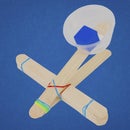Introduction: Busy Button Box - Montessori-style Electronic Board Toy for Toddlers
Busy boards are great for toddlers to practice their motor skills, independent play, and concentration. However, my 18-month old has spent far more time playing with light switches around the house than any busy board!
I shopped for an electronic button box toy that has a motorized element and Montessori-like design, but none exist, so the Busy Button Box was invented!
This is the third version of the button box. If you'd like to see my thought process while I was designing (and redesigning!) this project, take a look at the video. For just the step-by-step directions, read on.
- If you have feedback on how to make this project better, please share! I normally invent STEM activities for kids so this project is outside of my expertise. I'm sure there's room for improvement!
- This project guide uses some fancy tools! If you don't have access to a laser cutter or 3D printer, then please take this Instructable as inspiration to build something using the tools at your disposal. In the video you'll see that my first prototypes were made of cardboard and hot glue!
Safety notice: This product of this Instructable has not been reviewed by any child safety agency. Only use under close adult supervision.
Supplies
Tools:
- Scissors
- Soldering iron
- Wire stripper
- Hot glue gun
- Wood clamps, at least 12" long
- Sander with 180 grit sandpaper
- Drill with 1/16" bit
- 3D printer (I use a Creality CR-10)
- Laser cutter (I use a basic Glowforge)
Adhesives:
Fasteners:
- Assorted small wood screws (M1.7x4, M1.7x8, and M2x12)
- Assorted nylon nuts, bolts, and washers (sizes M3x20 and M4x20)
- Strap-style cable organizers (x2)
- #8 1/4" wood screws
Box assembly:
- 6mm laser-safe plywood
- 3mm laser-safe acrylic
- Food-safe wax and lint-free cloth
Buttons and switches:
- Standard US single-pole toggle light switch
- Standard US single-pole paddle light switch
- Toggle and paddle switch cover plate
- 12mm toggle push buttons (x5)
- 19mm metal momentary push button
- 21mm on/off rocket switch
- 12mm metal momentary push button (Optional)
Lights:
- 5mm LEDs, assorted colors (x4)
- 5mm LEDs, RGB fast phasing (x3)
- 3V solar string light replacement bulbs (x2)
Motor assembly:
- Gearbox "TT" motor
- Low voltage motor speed controller
- Motor mount
- 3D printed controller knob (file attached in step 9)
Wire and Batteries:
- 30 AWG silicone electrical wire
- 24 AWG bar wire
- Small wire nuts (x2)
- 3xAA battery holder
- AA batteries (x3)
Bumpers:
Step 1: Cut Out the Pieces
Cut out the 6mm wood pieces with a laser cutter using 6mm laser-safe Baltic birch plywood. On a basic Glowforge laser cutter, the settings are Full Power and 115 speed. Plywood width may vary so be sure to test your settings.
The 3mm laser-safe acrylic is cut with full power and 157 speed.
The box pieces were designed on www.makercase.com
Step 2: Glue the Box Together
On all 4 the side pieces: Apply wood glue to the inside of the slots and to the side of the tabs facing the main top piece.
- Tip: Use an old paintbrush to apply the glue. It's fast and helps get the glue into the corners.
Clamp the box together from all sides, then use mini clamps or binder clips to clamp the thin edge of the large opening to the side of the box. Make sure the opening for the 21mm master toggle switch is on the front of the box.
- Tip: If you don't have enough clamps, wrap the outside perimeter of box tightly with something like a bungee cord, then put a wide, heavy object on top.
Finish the box assembly by gluing the motor speed controller mount into its slot, and create the battery holder compartment by gluing the remaining 3 laser cut rectangles together into the corner of the box as shown.
Step 3: Sand and Wax the Box
Remove all scorch marks and clean up excess glue with 180 grit sandpaper. Sand the outside of the box, the back plate, and both sides of the laser-cut propeller. Wipe off the wood dust before proceeding.
Next, prepare to coat the box in wax by covering the corners with masking tape. 3/4" width tape is ideal, but 1" will work too.
What's the masking for? In the last step, the foam safety bumpers are attached to the corners with adhesive. The adhesive doesn't adhere well to the waxed wood, so masking the corners will ensure a better bond.
Thoroughly coat the outside of the box and back plate with wax according to the wax's instructions. This gives the box some protection from sticky toddler hands!
Step 4: Install the Buttons and Switches
Prepare the household switches by wrapping 3-4" (8-10cm) lengths of bar wire around the terminals. Doing this now is much easier than later, after the switches have already been installed.
Attach the switches in their respective cutouts using short wood screws.
- Important! Make sure the top of the switches are next to the acrylic window cutout. The word "Top" will be embossed onto part of the switch.
- Tip: The dual switch cover plate has very small tolerances, so it's important that the switches are almost perfectly aligned with each other. To do this, place the cover plate over the switches before firmly tightening down all the screws. Wiggle the plate until it fits over both switches, then carefully remove the plate and finish tightening the screws.
Attach the toggle and momentary buttons into their respective cutouts. You can order the colors of the momentary buttons however you want.
- The 12mm momentary RGB LED button pictured is metal, but you could use another plastic one if desired.
Step 5: Install the 5mm LEDs
For the assorted color LEDs: Match the colors of the LEDs with the buttons. Rotate the LEDs so the positive terminal is facing the buttons. Spread the wire leads apart, then apply a generous glob of hot glue behind the LED.
For the RGB phasing LEDs: Face the positive terminals toward the momentary button, then repeat the same hot glue technique.
Step 6: Install the Light Bulb Mounts
The lightbulbs will be mounted inside the box with large strap-style cable organizers. Prepare the cable organizer with a lead wire for the bulb by wrapping a 4" (10cm) length of bar wire several times around the middle of the strap.
Why not solder wire onto the bulb? The heat from the soldering iron can destroy the electronics inside the light bulb. Also, the metal casing requires a very high temperature to form a solder bond - even with rosin - so it's very easy to overheat and destroy the lightbulb's circuitry.
Attach the cable organizers above the center of the switches. Align the edge of the cable organizer base with the acrylic window cutout.
Use a small screw and washer to secure the base of the strap to the box. The other side of the box will be covered with the switch plate, so it's okay if the screw goes through the wood.
- Important! Make sure the straps are pointing away from each other when fully open, as pictured. If the straps are pointing the same direction, then the lightbulbs will appear unaligned with the switches.
Step 7: Install the Lightbulbs
Create a wire lead for positive terminal of the bulb by cutting a 4" (10cm) length of bar wire, then bend a small loop on one end. Position the loop over the bottom of the bulb, then hold it in place with a tightly stretched piece of electrical tape.
- The tape also provides some friction to help keep the bulb strapped in.
Repeat with another bulb, then strap both bulbs in place as shown. You may need to use a pair of pliers to pull the strap tight. Use a glob of hot glue near the end of the strap to help prevent it from coming undone.
Step 8: Install the Battery Holder and Motor Controller
Use two small screws (M1.7x4) to secure the battery holder as shown.
Use four small bolts with nuts and washers to hold the motor controller in place. I used M3 nylon bolts, then trimmed off the excess and used a little CA glue to ensure the nuts doesn't loosen over time with the vibrations from the motor.
Step 9: Install the Motor and Knob
Fit a M4 bolt into the motor mount, then snap the mount onto the metal motor casing. Make sure the copper motor terminals are exposed.
Use a nut to secure the motor to the box. Trim off the excess bolt and apply a little CA glue to ensure it doesn't loosen.
3D print the knob with at least 25% infill. To attach the knob: First turn the metal dial counterclockwise until it clicks into the off position. Use one hand to support the motor controller dial, then push-fit the knob on. I suggest orienting the knob so the indicator circle is pointing to the lower left corner of the box.
- If you'd like to modify the knob, you can find it on Tinkercad.
Lastly, fit the laser cut propeller onto the plastic motor shaft. All the hardware installation is complete!
Attachments
Step 10: Connect the Electronics
Thanks to user Killawhat for showing me how to make a simpler circuit diagram, shown here (see the last image for the original diagram).
I made this using circuit-diagram.org.
Click on the images for notes about how to wire the electronics without following a diagram.
Step 11: Finish and Test the Electronics
Connect all of the grouped positive and negative terminals together into two respective hubs.
Cap off the hubs with wire nuts, then install 3 AA batteries and give everything a test!
Step 12: Add the Acrylic Covers
Use 1.7Mx8 screws to attach the acrylic covers over the window cutouts. Tighten slowly by hand to avoid over-tightening and cracking the acrylic.
Optional: You can further secure the large acrylic window by applying a thin coat of CA glue to the screw threads just before use. Don't put CA glue on the battery compartment cover screws!
Step 13: Attach the Back of the Box
Align the backplate with the box, then hold it in place with clamps. Using the precut holes in the backplate as a guide to drill pilot holes into the sides of the box using a 1/16" bit.
Keep the clamps in place, then use M2x12 screws to attach the backplate to the box.
Step 14: Add the Bumpers
Apply furniture pads to the corners of the box. These protect the surfaces that the box is placed on.
Next, install the corner bumpers:
- Cut 2" (5cm) foam pieces (x4).
- Cut the adhesive strips into 2" (5cm) pieces (x8).
- Apply the adhesive strip to the inside faces of the foam corner bumper.
- Align the foam carefully onto the corner of the box, then press on the corner firmly for 30 seconds.
The box is complete! If you made one yourself or have any feedback on this design, please share with me. I'm unfamiliar with a lot of the materials and processes that were used in this project so I'm open to redesigning the button box again in version 4!

First Prize in the
Toys and Games Contest















